- HOME
- ABOUT US
- SOLUTIONS
- Metal Roof PV Mounts and Systems
- Flat Roof Solar Panel Mounting Systems Solutions
- Tile Roof Solar Mounting Systems Solutions
- Solar Tracking Solutions for Commercial PV Projects
- Ground Solar Mounting Systems Solutions
- Floating Solar Solutions - PV Systems
- PV Solar Carport Mounting Systems Solutions
- Balcony Solar Panel Mounting Systems Solutions
- PRODUCTS
- PROJECTS
- COMPANY NEWS
- BLOG
- Contact Us
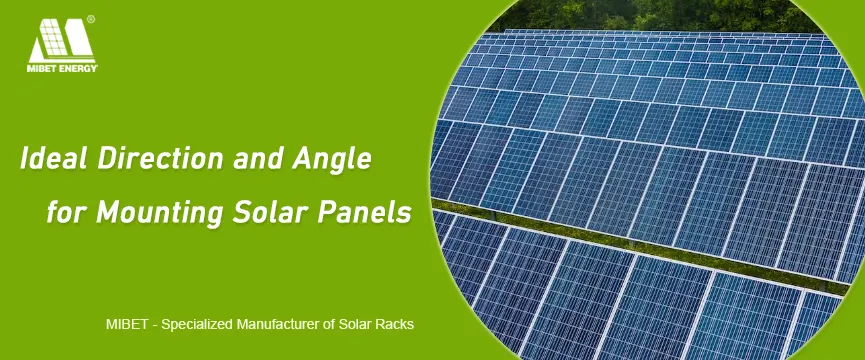
Solar panels generate electricity by converting sunlight into energy. Naturally, the amount of sunlight directly impacting the panels significantly influences their efficiency. Therefore, carefully considering the angle and orientation of your solar panels during installation is crucial for maximizing their energy output.
This piece will discuss the elements that influence the placement, for solar panels. By understanding these key considerations, you can make informed decisions about the system that best suits your needs and location.
Importance Of Solar Panel Orientation
When installing solar panels, their direction plays a critical role in their effectiveness. While it might seem intuitive to simply place them facing any direction, the reality is that orientation significantly impacts their performance and energy output.
Generally, solar panels in the Northern Hemisphere are installed facing true south, while those in the Southern Hemisphere face true north. This positioning ensures maximum exposure to sunlight throughout the day, leading to optimal energy generation.
Deviating from this ideal orientation can lead to a noticeable drop in efficiency. For instance, panels facing directly east or west may experience a decrease in energy production by approximately 20%. This highlights the importance of prioritizing proper placement to maximize the sun's energy capture.
It's also important to note that the angle of the panels, in addition to their direction, affects energy production. An incorrect angle can significantly reduce electricity generation. Therefore, careful consideration of both direction and angle is crucial for ensuring your solar panels operate at peak efficiency.
Importance of Solar Panel Angles
The angle at which solar panels are mounted also affects energy production efficiency. Capturing sunlight at the optimal angle increases the energy generated by your system, providing more electricity for home use and potentially even some extra to sell back to the grid.
Imagine a solar panel lying flat, measuring 1 meter in width.
During summer at noon, when the sun is directly overhead, a 1-meter wide column of sunlight will fully strike the panel:
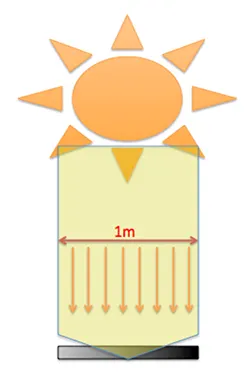
However, if the sun's angle is 30° from the ground, the sunlight spreads over a 2-meter area, reducing the light received by the panel to half:
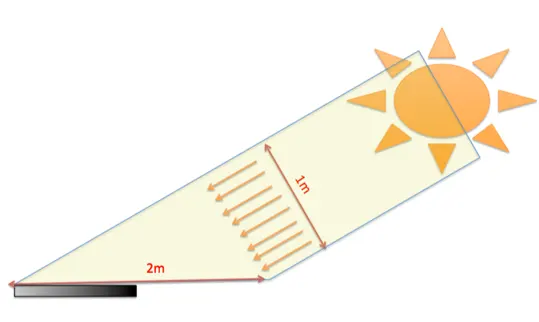
In this scenario, the panel gets only 50% of the potential sunlight, leading to a 50% decrease in energy production compared to when the sun is directly above.
To counter this, adjusting the panel to a 60° tilt will ensure it captures the maximum sunlight:
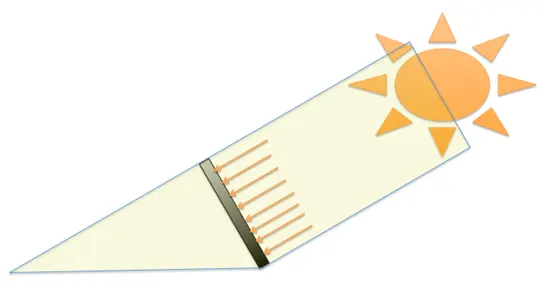
So What Is the Best Angle for a Solar Panel?
To capture the most sunlight throughout the year, adjusting your solar panels' tilt angle seasonally is key. Generally, solar panels should be positioned more upright in winter to capture the lower angle of the sun, and angled more sharply in summer to optimize energy production. Here are two straightforward methods for calculating the ideal angle for your location.
Method one
This simple method involves adding 15 degrees to your latitude for winter and subtracting 15 degrees for summer. For example, if you live at a latitude of 34°, your optimal winter tilt angle would be 49° (34 + 15), while the ideal summer angle would be 19° (34 - 15).
Method two
This refined approach offers improved results by factoring in the sun's midday intensity. For winter, multiply your latitude by 0.9 and add 29°. Using the same 34° latitude example, the winter tilt angle becomes 59.6° ((34 * 0.9) + 29), maximizing exposure to the potent midday sun. For summer, multiply your latitude by 0.9 and subtract 23.5°, resulting in a 7.1° angle ((34 * 0.9) - 23.5) in our example. During spring and fall, simply subtract 2.5° from your latitude for the optimal tilt angle.
Factors that Affect Solar Panel Angle
The ideal angle for your rooftop solar panels is influenced by a combination of factors specific to your location, roof, and season.
Latitude
Your geographic location plays a key role in determining the optimal tilt angle for your solar panels. Latitude dictates the sun's average position throughout the year. By adjusting the angle based on your latitude, you ensure better alignment with the sun's path, maximizing solar exposure.
While latitude provides a general guideline, online tools and resources can help you calculate the ideal tilt for your specific location. A simple Google search for the latitude of your home address or zip code can be a good starting point. Typically, the ideal angle will be close to your latitude, often falling between 30 and 45 degrees. However, seasonal adjustments may be necessary for optimal performance.
Your Roof
For maximum energy production, your roof needs to meet certain requirements. Consulting with a professional solar company can help assess how the following factors might affect the optimal angle of your solar panels:
● Roof Angle: Every roof is unique, from steep slopes to flat surfaces. Depending on your roof's angle, your installer may need to adjust the tilt of your panels using additional support structures. This process can be more complex for roofs with multiple pitches and shapes.
● Roof Shape: The shape of your roof also plays a role in solar panel placement. Gable, hip, and flat roofs are generally considered ideal for solar installations, offering optimal sunlight exposure. However, intricate architectural elements can complicate panel placement and angle calculations.
● Roof Shading: Since solar panels rely on sunlight to generate electricity, any shade significantly reduces their efficiency. It's crucial to place your panels in areas with minimal shade throughout the day and year. This requires careful consideration of nearby objects and their potential to cast shadows as the sun moves.
Seasonal Adjustments
Seasonal changes can significantly impact solar panel efficiency. During winter, when sunlight is less intense and lower in the sky, energy production may decrease. To optimize year-round performance, consider adjusting the tilt of your panels twice a year – steeper angles in winter and shallower ones in summer. This helps capture more sunlight during each season.
Additionally, if you live in a region with heavy snowfall, steeper angles can help snow slide off your panels more easily, ensuring optimal energy production throughout the winter months.
Optimal Direction for Solar Panel Mounting
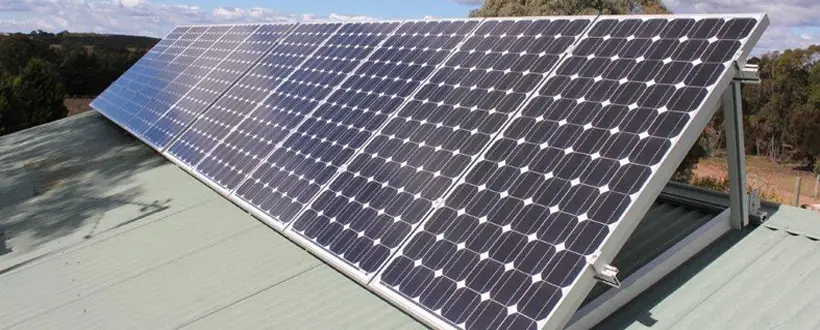
The orientation of your roof is crucial in deciding the amount of sunlight that your solar panels will get during the day. For those residing in the Northern Hemisphere, the direction for solar panels is facing true south. This is distinct from south, which corresponds to the Earths magnetic poles. True south however lines up with the Earths axis. Guarantees a steady exposure, to sunlight all day long.
By aligning your panels with true south and considering the azimuth angle (the sun's angle relative to true north and south), you can maximize your system's energy production and efficiency.
Unsure of your roof's orientation? Google Maps can help! Simply search your address and use the grid to identify true south. Then, compare this direction to your rooftop's orientation on the satellite image.
Which Is More Important, Orientation Or Tilt Angle?
When planning your solar panel installation, you might wonder: what's more important, the direction they face or the angle they're tilted at? While both factors impact energy production, orientation takes precedence over tilt angle.
Consider this: Even if your solar panels are tilted at the perfect angle, they won't produce much energy if their backs are to the sun. This underscores the importance of ensuring that your panels are facing the direction.
Of course, the tilt angle isn't irrelevant. A well-adjusted angle allows for better light absorption and minimizes the angle of incidence, leading to more efficient energy conversion. However, even a perfectly tilted panel will underperform if its orientation isn't optimized.
So, when aiming for the best energy output, prioritize proper orientation first. Once you've got that nailed down, fine-tune the tilt angle to further enhance your system's efficiency. By striking the right balance between these two factors, you can ensure your solar panels reach their full potential.
Tracking vs Fixed Mounting Solutions
Fixed mounts, as the name suggests, secure your panels in a stationary position. This option typically requires less initial investment and ongoing maintenance compared to tracking systems. However, it's important to understand that fixed mounts may not capture the sun's energy as efficiently throughout the day, as they cannot adjust to the sun's changing position in the sky.
The tracking system allows the position of the panel to be adjusted in real time to track the movement of the sun. This enables them to harness sunlight and produce more electricity especially during peak times. However, this increased efficiency comes at a cost: tracking systems typically entail higher costs and demand more intricate upkeep in comparison, to stationary alternatives.
Ultimately, the optimal choice for your solar panel installation depends on your specific needs and priorities. Carefully evaluate your budget, desired energy output, and available space to determine which mounting system best aligns with your goals. Remember, factors like shading and potential obstructions on your property can also influence your decision.
Frequently Asked Questions
What if my roof is flat?
While flat roofs might initially seem like a less-than-ideal canvas for solar panels, fear not! Installers can utilize special mounting devices that tilt your panels at an optimal angle (typically around 10 degrees) to maximize sun exposure and energy generation. These mounts also cleverly deflect rainwater, allowing it to naturally wash away dust and grime that can hinder performance.
How efficient are solar panels at different angles?
Solar panels work best when they face south at a tilt between 30° to 45° don't worry if your roof or setup doesn't allow for this positioning. With lower tilts solar panels can still produce a good amount of power. Studies indicate that even reducing the tilt angle to as little as 5° only leads to a modest 10% drop in yield. This means that even with less-than-ideal tilt angles, your solar panels can still operate at relatively high efficiency levels, ensuring effective energy generation for your needs.
Do solar panels need to be south-facing?
While south-facing solar panels generate the most energy, don't worry if your roof or property layout isn't perfectly suited for this orientation. East or west-facing panels can still capture sunlight and produce power. Ultimately, the best angle and direction for your specific setup will depend on various factors, including your location and roof configuration. Most solar companies are happy to provide expert guidance and advice to help you optimize your solar energy system for maximum efficiency.
Do seasons affect solar panel angle?
To optimize energy generation it's helpful to tweak the tilt of your panels as needed. Typically you can adjust the angle by up to 15 degrees in either direction from summer, to winter. For example, if your ideal tilt angle is 30 degrees, you might consider lowering it to 15 degrees in July and raising it to 45 degrees in January.

